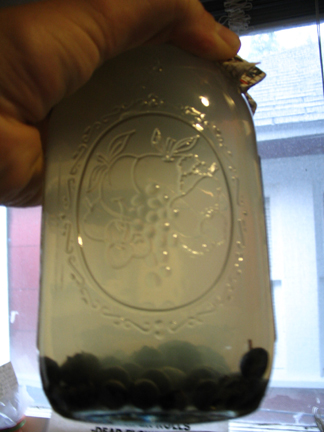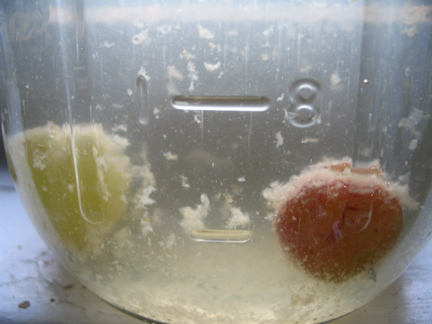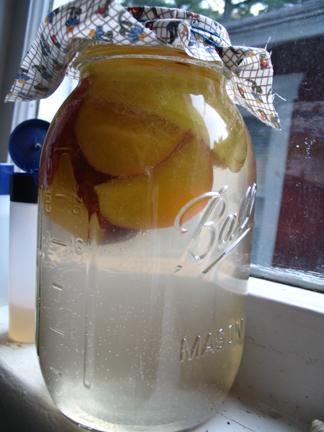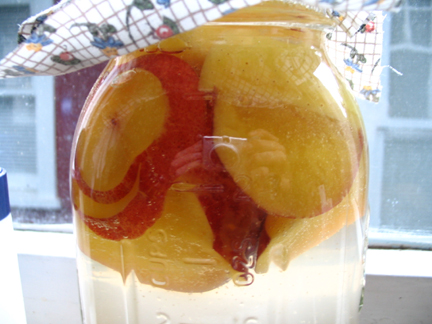Fruit scrap vinegar
I have identified several food items that I currently use that will need to be replaced, replicated or removed from my diet in the near future. Many of these things are basic condiments such as mayonnaise, ketchup, and mustard, which I can most likely make myself if the proper ingredients are available. Other things such as olive oil and balsamic vinegar are out of the question, as their travel log comes in at several thousand miles.
I use vinegar with oil on my salads primarily, and I can see using vinegar in homemade condiments as well when the time comes. I am currently out of balsamic vinegar, which I could drink by the glass if need be. It is very smooth, and I can tell it has been aged well. So I am now relying on the last 1/4 of a bottle of Bragg’s Organic Apple Cider Vinegar for my salad topping. Apple cider vinegar is way more harsh than balsamic. This particular brand is also raw and unfiltered, which I think gives it more of a bite. The bottle label also has a picture of a lady with a weird hat on that makes it an interesting conversation piece on the dinner table. I dilute this apple cider vinegar substantially with oil and seasonings when I make a salad dressing. It still has an edge to it, but it blends better with the other flavors in the salad.
The apple cider vinegar might last another month. In anticipation of running out of this vinegar I turned to the pages of Wild Fermentation for instructions on making my own. With what I had available I was able to start three different types of vinegar in order to do some taste testing and experiments on fermentation time. The first is a blueberry based vinegar using local berries from Newberry’s Blueberries (19 miles) and local raw honey Olsen Gardens (48 miles) as the sugar source instead of the rapidly disappearing organic raw sugar in the cupboard.

The beginnings of vinegar fermentation are the same as the beginnings of wine or beer brewing. At a point in the fermentation process, the blueberries could be dumped out and the honey water could be capped with an airlock to create the anaerobic environment necessary for the mixture to become an alcoholic beverage. I would end up with a honey wine that could be bottled and aged or consumed then and there. We’ll get to that project soon enough, just as soon as the airlock arrives.
Instead I’ll dump the blueberries in about a week and leave the mixture open to the air as the aerobic process continues and wild aerobic creatures (yeast like Mycoderma aceti and bacteria in the Acetobacter genus) exhaust the developing alcohol and make vinegar. The whole process should take about three weeks.
Already the second mixture, a bruised apricot and “floor grape” concoction, is fizzing dramatically. A “floor grape” is a grape that fell on the floor at the co-op. Yes, I rinsed them. The bubbling is audible at this point, just a little over 24 hours into the ferment. I used raw sugar in this jar, and I think that makes a bit of difference. Sandor writes in Wild Fermentation that honey based ferments might take a bit longer.

You can see the red and green grapes dissolving. The apricot is floating at the top of the jar. The nectarine/apple mixture is also fizzing audibly; it is another raw sugar mix. The apple is a golden delicious that was bruised and wrinkled in the case it came in and never made it to the shelf. The yellow nectarine had a small bit of mold on its side and a bruise. It also never made it to the shelf. These fruits were destined for the compost bin, but now they are serving a higher purpose on the kitchen counter.

I think the apple/nectarine jar is the prettiest at the moment. The fruits aren’t dissolving like the grapes or just hanging around in a darkened liquid like the blueberries. Here are the fruits up close –

Don’t put your vinegar ferment in the windowsill. I just did this to get a decent photo. So, if you are curious about how to make fruit scrap vinegar, here are the basic instructions:
1 – Ask a worker in a grocery for some bruised or damaged fruit. Ask someone at a local food co-op or natural food store and you will have much better luck. Grocery stores aren’t interested in giving anything – including unfit fruit – away for free. They would rather see it in the dumpster, which is another perfectly good place to find your starter fruit.
A second option is to just eat a piece of fruit or two and save the skin and cores. These are a perfect start for the vinegar.
2 – In a quart jar, mix a 1/4 cup of sugar or honey with almost a full quart of water. Leave enough space for the fruit. Completely dissolve the sugar or honey in the water then add your fruit.
3 – Cover the jar with some fabric or cheesecloth and hold it in place with a rubber band or two. This is to keep the flies and dust out but to let oxygen in.
4 – Dump the fruit in about a week or when the liquid begins to darken a lot.
5 – Ferment for another 2 or 3 weeks, stirring the liquid whenever you have the chance.
6 – Enjoy your vinegar. At this point it will be stable and can be kept in a cool cupboard or in the fridge.
These steps are adapted from the fruit scrap vinegar instructions in Wild Fermentation by Sandor Ellix Katz. This won’t be the last you hear of this book on this blog, so if this all sounds interesting, please order a copy. You won’t be disappointed.
2 Responses to Fruit scrap vinegar
June 28, 2007 at 11:27 am
Trace, we must swap ideas more often! Love the blog and love the idea of fruit scrap vinegar even more! Just yesterday I was in Trader Joe’s eyeballing a grapefruit vinegar but decided it wasn’t worth the $. Time to go make a home brew of my own with my breakfast leftovers…
Pingback: First Vinegar Attempt « TRASHY GOURMET